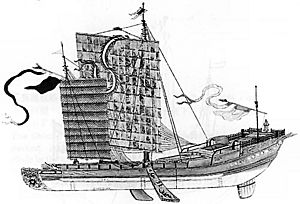Paul Chiasson facts for kids
Paul Chiasson is a Canadian architect and author. He has written books about his ideas about how North America was settled. These ideas are sometimes called "pseudohistories" because they are not accepted by most historians.
In his first book, The Island of Seven Cities: Where the Chinese Settled When They Discovered America, Chiasson shares a big idea. He believes that Chinese sailors came to Nova Scotia almost 100 years before Christopher Columbus. He thinks they settled near Cape Dauphin. He suggests that the local Mi'kmaq culture was influenced by these Chinese visitors. He points to things like old remains, customs, clothing, art, and even their language.

Why Experts Disagree
Most historians do not agree with Paul Chiasson's theory. Experts like archaeologists and geologists from Nova Scotia have looked at his evidence. Chiasson said that a road and stone wall on Cape Dauphin were proof of a Chinese settlement. However, these experts found that the "road" was built in 1952 by firefighters. The "wall" was built in the 1990s by a company digging for gravel.
Paul Chiasson challenges these findings in his second book. It is called Written in the Ruins: Cape Breton Island's Second Pre-Columbian Chinese Settlement.
The Documentary and Expert Opinions
In December 2010, a TV show called "Mysterious Ruins: Cape Breton" aired on History Television. This show looked into Paul Chiasson's theory. It included interviews with experts who visited the site Chiasson believed was a Chinese community.
Sandra Barr, a geologist from Acadia University, and Steve Davis, an archaeologist from St. Mary's University, were interviewed. They both said they found no proof of any human settlement at the site. Acadia University later noted that their explanations were mostly ignored in the film.
The documentary also showed interviews with Chinese architectural historians. Dr. Zhu Guangya, a professor from Southeast University in Nanjing, said he believed the site was from a human settlement. He added that more study was needed to confirm what kind of settlement it was. Professor Fang Yong also said that what Chiasson found was not enough to prove it was a Chinese ruin, but that it was "possible."
See also

